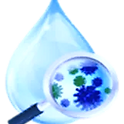
DISEASE DETECTIVES


(a)

(b)

(c)

Figure 1. (a) Escherichia coli (E.coli) bacteria, (b) Giardia parasite, and (c) Cryptosporidium parasite
Indigenous populations - chlorine pollution
Our team focused on connecting our topic of anthropogenic pollution of municipal wastes into wetland ecosystems as an application. In order to study this effect we focused on, impacts of pollutants on Indigenous populations as a case study. Both teams looked at how Indigenous populations are affected by minimally treated wastewater and how this can harm their physical health. For instance, our team specifically looked at how chlorine released from road salts can spread into nearby coastal wetlands. We examined how chlorine pollution is present in tap water of Indigenous households and fears of consuming this water and its risks on human health, steer these individuals towards non-potable water resources to obtain water which potentially contain harmful contaminants such as E.coli, giardia, and cryptosporidium (Awume et al., 2020). This area of research relates to our first and second research question.
Sources: (a) https://www.watercanada.net/alarmingly-high-e-coli-levels-in-first-nations/ (b) https://www.cdc.gov/parasites/giardia/index.html (c) https://www.cdc.gov/parasites/crypto/index.html
Policies & Strategies to Conserve Wetlands
Additionally, Team Transform3rs is working on restoring and reconciling the wetland to prevent harm. In order to do this, they are connecting with our team to discuss policies and strategies to conserve wetlands. This is a great area for linkage as our team looked at a case study in China where elements of coastal wetland degradation were analyzed (Liu et al., 2020). For instance elements such as wetland degradation, coastal erosion, environmental pollution, and non-native species invasion caused by natural and man-made factors were examined. The authors have proposed coastline restoration, coastal wetland recovery, and coastal ecological corridor designation and development to help protect and conserve their wetlands (Liu et al., 2020). According to the study, these measures have proven successful as it is clearly reflected by the larger coastal wetland areas and stable numbers and diversity of species present in their coastal ecosystems today. This connects directly with our third research question. Both our teams looked at combating pollution and contamination issues within Indigenous populations. Specifically, they looked at the Walpole Island First Nation population, who is working on conserving and restoring the wetland, Swan Lake Marsh, an area once used for waterfowl hunting (Government of Canada, 2017).

Figure 2. Walpole Island - First Nation
Benthic Macroinvertebrates as Bioindicators
Additionally, both our teams are looking into protecting these ecosystems as they benefit many species. Therefore, the use of indicators to assess wetland health was another connection that was established between our teams. Specifically, we found that both our teams were looking at the use of benthic macroinvertebrates to measure the health and quality of wetland ecosystems. There was a study regarding the use of benthic macroinvertebrates in Andean wetlands in Peru where the researchers would investigate the impacts of specific anthropogenic disturbances in wetland ecosystems. The reactions of these benthic macroinvertebrates to different environmental stressors would be an effective practice to evaluate the water and habitat quality of coastal wetland ecosystems as 70% of the indicators used in the study were shown to have interacted with the wetland environment (Custodio et al., 2018). This topic is also associated with our third research question where we are determining different methods to track the presence of road salts in coastal wetlands and looking at different biological indicators to assess wetland health. This will allow us to look at the effects of these disturbances on the health and diversity of microbial communities residing in the waters.
References
Awume, O., Patrick, R., & Baijius, W. (2020). Indigenous Perspectives on Water Security in
Saskatchewan, Canada. Water, 12(3), 810. https://doi.org/10.3390/w12030810
Custodio, M., Chaname, F., Pizarro, S., & Cruz, D. (2018). Quality of the aquatic environment and diversity of benthic macroinvertebrates of high Andean wetlands of the Junín region, Peru. The Egyptian Journal of Aquatic Research, 44(3), 195-202.
Government of Canada. (2017, February 3). Supporting the work of First Nations in Wetland restoration: Swan Lake Marsh, Walpole Island First Nation.
Liu, L., Wang, H., & Yue, Q. (2020). China’s coastal wetlands: Ecological challenges, restoration, and management suggestions. Regional Studies in Marine Science, 37, 101337. doi:10.1016/j.rsma.2020.101337